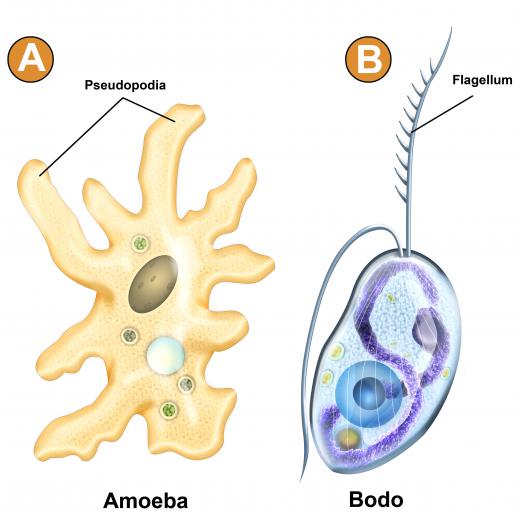What is a Unicellular Organism?
 Michael Anissimov
Michael Anissimov
A unicellular organism is any life form that consists of just a single cell. This group includes most life on Earth, with bacteria serving as the majority. The main groups of single celled life are bacteria, archaea (both prokaryotes), and the eukaryota (eukaryotes). The differences between the prokaryota and eukaryota are significant: eukaryotes possess a nucleus, while prokaryotes lack it, and eukaryotes possess a range of subcellular organs called organelles, while prokaryotes are very minimal.
People can observe the larger unicellular organisms, such as amoebae, by using the higher settings on a light microscope. Bacteria are so small that they just appear as dots under such magnification. To gather them for observation, a person can place a cover slip on the surface of pond water, and leave it overnight. By the next morning, many organisms will have grown entire colonies on the bottom of the slip. They replicate fast: colonies can double their size in between 30 minutes and a few hours.

Unicellular organisms as diverse as they are ubiquitous. The oldest forms of life, they existed 3.8 billion years ago, if not longer. They pursue a variety of strategies for survival: photosynthesis (cyanobacteria), chemotrophy (many archaea), and heterotrophy (amoeba). Some have flagella, little tails they use for locomotion, or lobopods, extensions of the cellular skeleton (cytoskeleton), which appear as bloblike arms. The flagella of the unicellular ancestors of humans is retained all the way up into the animals, where it makes an appearance as flagellated sperm.

Of all the six eukaryote supergroups, four are exclusively composed of single cell organisms. Only the opisthokonts, consisting of animals, fungi, and close relatives, and the archaeplastids, consisting of both unicellular and multicellular plants, are exceptions. These organisms vary in size, with the smallest bacteria measuring 300 nanometers across, ranging up to the titantic plasmodial slime molds, which can grow to 8 inches (20 cm) across. The largest may have millions of nuclei scattered throughout the cellular envelope. To observe some of the smallest requires an expensive electron microscope, while the very largest can be seen with the naked eye.
AS FEATURED ON:
AS FEATURED ON:
















Discussion Comments
Can anyone help me? What do unicellular organisms look like?
@anon72078-- They have many different functions. For example, the bacteria in our gut helps with digestion.
@turquoise-- What you described is correct. Many unicellular organisms reproduce through asexual reproduction. They do this by replicating their DNA and splitting it into two. The process of this split is called "binary fission."
Some unicellular organisms don't use fission, but rather budding. The difference is that budding produces a smaller cell rather than one that is equal in size. Unicellular organisms that reproduce are called a mother cell and the smaller one is called the daughter.
I hope this helps. You should also check out unicellular organism fission pictures. You can see clearly how they divide. It is cool.
How do unicellular organisms multiply exactly?
I know that bacteria sort of split into two and as each new bacteria also splits into two, they quickly go from one bacteria to two, to four, to eight, to sixteen and so forth.
I think this is really cool. I want to know how they do this.
this website is great and so helpful. i found all my info about cells here and i posted it on my project and got an A. I thank this website a lot!
amazing website, helps me finish my biology assignments.
the article is so good. i got it on the first read, easy in terms. good one!
This site is so great.I found my reports here, thanks to this site. It helped me a lot.
This is really great because it is helping me finish my assessment tasks and it's all about this stuff.
nice article, but is there any info for multicellular organisms? i need it for some lame project my teacher asked us to do.
I like this.
what is a unicellular organism's responsibility? By the way, the article is good.
this article is a very good article. it gives a lot of information about unicellulars and stuff.Please enjoy what I said. Thank you!
No. 1 site for information!
good article
was not the numulith the largest unicellular organism?
thank you for all your help. it has given me a lot of information.
i had to study this for a weird science writing assignment. i guess it was helpful.
what is the unique part of a unicellular organism?
Could you give more information?
i like this stuff. i have a science project in my school. it is about unicellular organisms. i'd like to know more about this.
nice article, Brief and precise. Manoj Bhatt
This article is great!
Post your comments